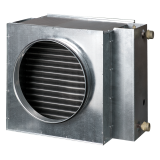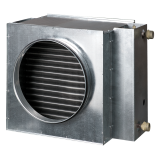Blauberg WKH 200-2
- Description
- Characteristics
- Downloads
- Designation key
- Dimensions
- Air pressure loss
- Calculation diagram
| FEATURES
For warming up of supply air in ventilation systems installed in various premises. Suitable for installation in supply or air handling units to warm up the supply air flow. For indoor use only if water serves as a heat carrier. For outdoor use antifreezing mixture (ethylene glycol solution). Compatible with Ø 100 to 315 mm round air ducts. DESIGNGalvanized steel casing. Copper pipe manifold. Heat exchange surface made of aluminium plates. Airtight connection with air ducts due to rubber seals. Equipped with a nipple for the system deaeration. Outlet header is equipped with a spigot for installation of an immersion temperature sensor or freezing protection mechanism. Available in two- or four-row coil modifications. Suitable for operation at maximum operating pressure 1.6 MPa (16 bar) and maximum operating temperature +100 °C. |
MOUNTING
Fixing to round ducts with clamps. Any mounting position that ensures the heater deaeration. Install a filter upstream to the heater to protect heating elements against dirt ingress. Install the heater in front or behind the fan. In case of mounting behind the fan ensure a distance of not less than two connecting diameters for air flow stabilization and keep the maximum permissible air temperature inside the fan. Connect the heater on counter-flow basis, otherwise its capacity drops by 5–15 %. All the nomographic charts are rated for counter-flow connection. For correct and safe heater operation an automatic control and protection system is recommended, including the following functions:
|
|
|
|
||

 Domestic fans
Domestic fans Industrial fans
Industrial fans Single-room air handling units with heat recovery
Single-room air handling units with heat recovery Air handling units
Air handling units  Smoke extraction and ventilation
Smoke extraction and ventilation Ventilation accessories
Ventilation accessories Ventilation ducts and fittings
Ventilation ducts and fittings Air distribution
Air distribution Measurement and control technology
Measurement and control technology Ventilation sets and vents
Ventilation sets and vents



/WKH-dimensions-250.png)
/WKH-air-pressure-loss-350-EN.png)
/graphs/WKH-150-160-200-2-graph-1000-EN.png)













